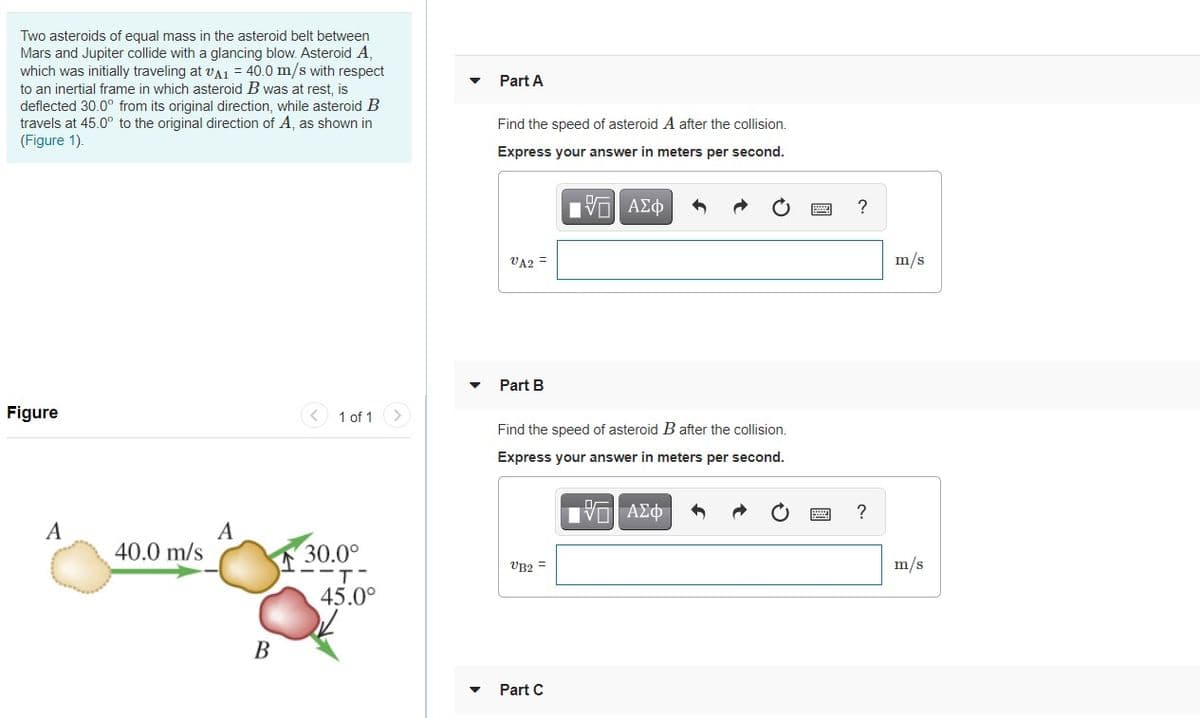Two asteroids of equal mass in the asteroid beit between Mars and Jupiter collide with a glancing blow. Asteroid A, which was initially traveling at vA1 = 40.0 m/s with respect to an inertial frame in which asteroid B was at rest, is deflected 30.0° from its original direction, while asteroid B travels at 45.0° to the original direction of A, as shown in (Figure 1). Part A Find the speed of asteroid A after the collision. Express your answer in meters per second. ? VA2 = m/s Part B Figure < 1 of 1> Find the speed of asteroid B after the collision. Express your answer in meters per second. A A 40.0 m/s 30.0° VB2 = m/s --T- 45.0° B Part C
Two asteroids of equal mass in the asteroid beit between Mars and Jupiter collide with a glancing blow. Asteroid A, which was initially traveling at vA1 = 40.0 m/s with respect to an inertial frame in which asteroid B was at rest, is deflected 30.0° from its original direction, while asteroid B travels at 45.0° to the original direction of A, as shown in (Figure 1). Part A Find the speed of asteroid A after the collision. Express your answer in meters per second. ? VA2 = m/s Part B Figure < 1 of 1> Find the speed of asteroid B after the collision. Express your answer in meters per second. A A 40.0 m/s 30.0° VB2 = m/s --T- 45.0° B Part C
Classical Dynamics of Particles and Systems
5th Edition
ISBN:9780534408961
Author:Stephen T. Thornton, Jerry B. Marion
Publisher:Stephen T. Thornton, Jerry B. Marion
Chapter9: Dynamics Of A System Of Particles
Section: Chapter Questions
Problem 9.36P: In an elastic collision of two particles with masses m1 and m2, the initial velocities are u1 and u2...
Related questions
Question
100%

Transcribed Image Text:Two asteroids of equal mass in the asteroid belt between
Mars and Jupiter collide with a glancing blow. Asteroid A,
which was initially traveling at va1 = 40.0 m/s with respect
to an inertial frame in which asteroid B was at rest, is
deflected 30.0° from its original direction, while asteroid B
travels at 45.0° to the original direction of A, as shown in
(Figure 1).
Part A
Find the speed of asteroid A after the collision.
Express your answer in meters per second.
Nνα ΑΣφ
?
VA2 =
m/s
Part B
Figure
1 of 1
Find the speed of asteroid B after the collision.
Express your answer in meters per second.
?
40.0 m/s
30.0°
VB2 =
m/s
45.0°
В
Part C

Transcribed Image Text:Part C
What fraction of the original kinetic energy of asteroid A dissipates during this collision?
?
Kdiss
Korigin
Expert Solution
This question has been solved!
Explore an expertly crafted, step-by-step solution for a thorough understanding of key concepts.
This is a popular solution!
Trending now
This is a popular solution!
Step by step
Solved in 2 steps with 1 images

Knowledge Booster
Learn more about
Need a deep-dive on the concept behind this application? Look no further. Learn more about this topic, physics and related others by exploring similar questions and additional content below.Recommended textbooks for you

Classical Dynamics of Particles and Systems
Physics
ISBN:
9780534408961
Author:
Stephen T. Thornton, Jerry B. Marion
Publisher:
Cengage Learning

Principles of Physics: A Calculus-Based Text
Physics
ISBN:
9781133104261
Author:
Raymond A. Serway, John W. Jewett
Publisher:
Cengage Learning

Modern Physics
Physics
ISBN:
9781111794378
Author:
Raymond A. Serway, Clement J. Moses, Curt A. Moyer
Publisher:
Cengage Learning

Classical Dynamics of Particles and Systems
Physics
ISBN:
9780534408961
Author:
Stephen T. Thornton, Jerry B. Marion
Publisher:
Cengage Learning

Principles of Physics: A Calculus-Based Text
Physics
ISBN:
9781133104261
Author:
Raymond A. Serway, John W. Jewett
Publisher:
Cengage Learning

Modern Physics
Physics
ISBN:
9781111794378
Author:
Raymond A. Serway, Clement J. Moses, Curt A. Moyer
Publisher:
Cengage Learning